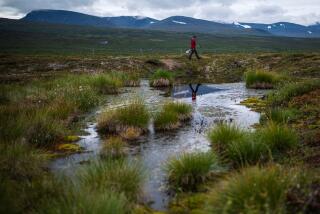Carbon cycle gets more extreme as climate changes
- Share via
Forests in Earth’s northern latitudes have been thickened by migrating plant species and younger growth, driving a stronger gyration in the amount of carbon that cycles between land and the atmosphere each year, a new study suggests.
The net rise in seasonal exchange of carbon between land and air cannot be explained solely by increased burning of fossil fuels, more wildfire or changes in the way the ocean cycles carbon, according to the study published online Thursday in Science. Researchers suspect major ecological changes are behind the trend in an area of the globe that is expected to bear the brunt of climate change.
Above the 45th parallel, the seasonal flux of carbon absorbed and released has increased about 50% over a half century, the researchers found. Lower latttudes did not exhibit as steep a change.
The natural exchange of carbon between air and land is one of the crucial intersections that preoccupies climatologists studying the effect of humans adding more and more carbon dioxide to the atmosphere.
The net amount of carbon dioxide in the atmosphere has been rising precipitously since the Industrial Revolution. How much Earth can reabsorb the carbon factors into models that aim to predict how climate will respond to the additional heat trapped by carbon dioxide and other greenhouse gases.
Forests and vegetation absorb carbon dioxide through photosynthesis, and store the carbon in various compounds. But the same vegetation also respires, dies and decays, returning carbon back into the atmosphere. It’s that short-term, seasonal cycle that appears to be swinging more wildly than it did some 50 years ago, the researchers found.
Although the northern vegetation areas likely are absorbing more carbon dioxide during growing season, the fluctuation can’t be explained only by a physiological response to warming and to the enriched carbon dioxide atmosphere.
“That suggests to us that there are some other changes occurring in the ecosystem that are causing an extra exchange of carbon over and above those two effects,” said Heather D. Graven, geochemist at Scripps Institution of Oceanography at UC San Diego, one of the authors of the study.
Such ecological changes are supported by other research showing that forest stand area has increased, while evergreen shrubs and trees have migrated northward into warming latitudes.
In addition, fire, logging and other disturbances are shifting the age composition of forests toward younger stands that experience shorter and more intense periods of carbon absorption. Picture a forest with the metabolism of a teenager.
“We don’t yet know if that’s enough to explain this change,” Graven said. “It’s probably likely that there are several mechanisms occurring in concert that are compounding to give us this larger increase in the seasonal exchange.”
Current climate models underestimate the effect of this fluctuation, which does not appear to be slowing down, according to the study.
The study used data collected from 2009 through 2011 during pole-to-pole monitoring flights, and compared it with readings from 1958-1961 at Mauna Loa, Hawaii and Barrow, Alaska. Both stations have collected data that show increased seasonal fluxes, though of slightly smaller magnitude than those calculated from the flights.
Overall, carbon uptake in the growing season of the northern latitudes likely increased about 40 to 60% since 1960, while carbon release fell 20 to 50%, the study suggested.
Northern, nontropical land areas absorb a net of about 2 billion metric tons of carbon annually, while humans add about 9 billion metric tons of carbon to the atmosphere each year, from burning fossil fuels, clearing land and other activities.
[For the record, 8:30 p.m. Aug. 10: An earlier version of this post incorrectly said that the 45th parallel marks most of the U.S.-Canada border. Much of the border is marked by the 49th parallel.]







